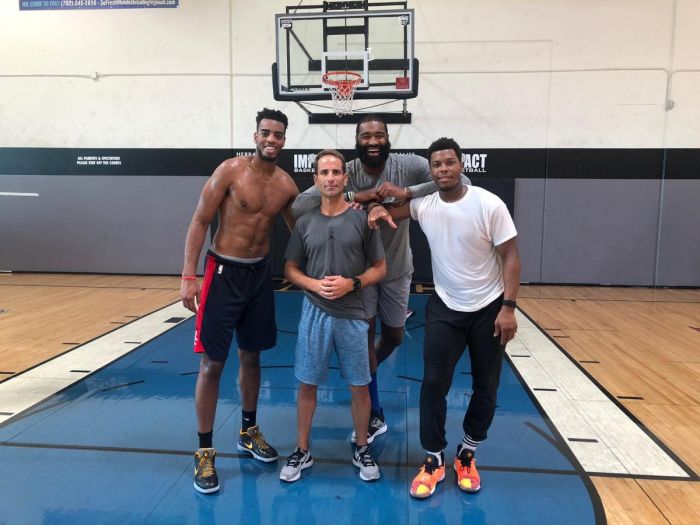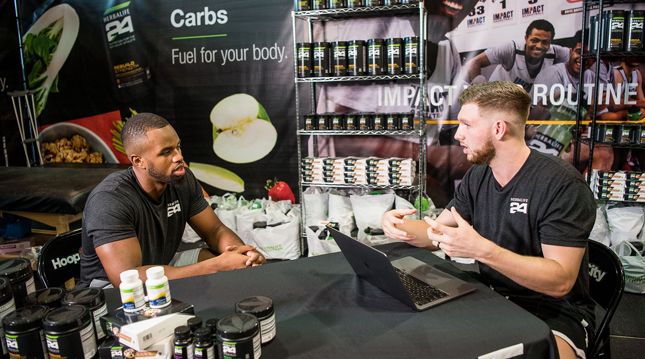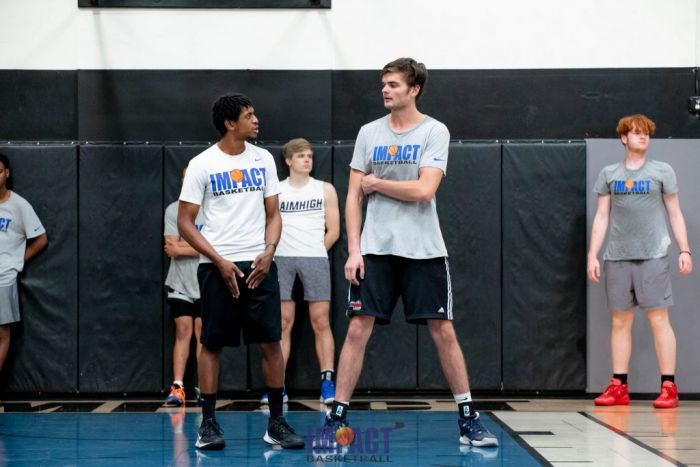Impact Basketball's arena facility is located in an inconspicuous location on Dean Martin Boulevard in Las Vegas.
The arena has two light-colored wooden floor basketball courts, including a scoreboard, a barbell exercise area, a temporary stretching area, a small kitchen for dining and snacks, and an office. There are not many flashy decorations, and the only conspicuous thing is the white banner hanging on the right wall, which lists the famous athletes in the 25-year history of this professional sports training venue.
Those names include: Kevin Garnett, Kawhi Leonard, Chauncey Billups, Kyle Lowry, Kelsey Plum, Tayshaun Prince, Jaylen Brown, Tyrese Haliburton, DeMarcus Cousins, John Wall, Al Harrington, Kristaps Porzingis, Nassir Little, Saddiq Bey and Ziaire Williams.
Impact Basketball was founded in 1997 by coach Joe Abunassar and is known for hosting occasional games during the NBA off-season. In the 2022 off-season, Spurs rookie Blake Wesley, Trail Blazers rookie Keon Johnson and Josh Green all joined Abunassar's pre-draft training camp and participated in the new trend of professional sports that combines technical training and intrinsic nutrition.


The timetable for Impact Basketball is very simple. Joining four months ago will significantly change the original training mode. The next step is to join the NBA through the draft, or become a free agent after being undrafted to fight for a contract. This job is practical and flashy, and the process is rarely interesting, but if you want to be a professional player, this is the path that will never stop.
But the results of hard work are likely to turn your life around.
“It’s not about winning or losing, it’s about reality, it’s about your salary, which could be millions of dollars or more,” said Isaac Mourier, Impact’s director of nutrition and exercise science. “When you use words like this to motivate them, they will be fully motivated. motivation to invest.”
Mourier is Impact's keyman. Mourier is from the UK and has played professional leagues in the UK and Germany. After retiring, he founded a sports nutrition consulting company and served as a nutrition consultant for the University of Georgia and the Kings. Mourier joined Impact in 2020.


(Mourier right)
In the two and a half years since joining Impact, Mourier has gone through three drafts. The computer is full of player information charts and progress charts, including the players' personalized goals. For example, a potential rookie needs to gain 20 pounds, reduce body fat by 2%, and lie down. Increase the pushing weight by 50 pounds and increase the vertical jump height by 2 inches.
Mourier is honored to work with players at this stage before the draft. For him, without the noise within the team and outside expectations, he and the players can have clear goals or plans.
"This is probably the first time they've experienced a group of people who really just want to help and get them to the NBA," Mourier said. "I always tell them, I just want to get you to the NBA and keep you there. Well, I don’t care if you win or lose now, I just want to think about the goal we want to achieve together.”
Impact training camps begin at the end of their respective seasons and begin with physical testing to build a complete body profile. This includes Impact's exclusive technology, including bioresistance analysis, which uses electrical current to scan body composition and read sweat spots to interpret how much sodium a player's body needs to absorb. etc.
Important physical indicators such as blood test status, stress hormone levels, nutritional status, body water content before and after exercise, body fat, etc., allow Impact to first establish a player's baseline strength and needs.
In the training camp, every potential rookie can get an exclusive growth path. Skill development is part of this, with players training together in small groups.
"We will observe, analyze and evaluate all conditions on the court. If a player is blocked when cutting, or the lower body strength is insufficient when making a jump shot, it means that they need to strengthen their lower body strength. Every court situation will make us think about the key points that need to be focused on. How to adjust the training room, training hall or diet and nutrition." Abunassar said, "Therefore, everyone's plans and projects are different, and they have different goals."
Hydration and dietary control are also key factors. Mourier works with local chefs to create and execute meal plans, down to every meal, snack and supplement. At the same time, Impact regularly monitors players' physical indicators, sleep schedules, emotions and mentality. According to Mourier's estimate, there are about 20-25 Impacts involved in assisting in the development of each player.
Mourier also repeatedly emphasized that technology, diet and training are not the main reasons for players to enter the NBA. The most important thing is to reshape their habits and instill health discipline.
"When a player's bad habits reach a point of deep dependence, he will think that I am already the best player in the world, why do I need to seek change? This is the mentality we need to change. When we do this, the players will Understand that the only way to success is to consistently start small,” said Mourier.
At the basketball level, from AAU, NCAA to professional leagues, a lot of power lies in the hands of players. "Many players will think, why are you telling me what to do? We have to break this barrier, and when we target It's easier when you're consistent," Mourier said.
However, establishing the right habits is bound to have a painful period for players, so if they want to maintain their position in the league, they must continue those boring routines from the end of training camp to the draft, and even after joining the NBA.
Mavericks forward Josh Green joined Impact in 2020, and he continues to cooperate with Impact until now. Green trained in Las Vegas during the offseason, and part of that plan was to cut back on butter.


Green started dieting after undergoing his second shoulder surgery in 2019. After joining Impact, Green has been struggling to balance heavy consumption during training with eating. His off-season goal is to reduce carbohydrates to a minimum and not eat snacks.
"When you're young, you have to seize every opportunity in front of you," Green said. "I started playing here very early, and I realized very early on that if you want to have a long career, it's important to keep your body in the right place. A healthy state."
Abunassar has countless examples of top athletes starting to pay attention to diet science at Impact. Garnett posted Impact's diet plan on the refrigerator in Minnesota. Lowry, Haliburton and Serge Ibaka also improved and successfully improved their postures under Impact's guidance.
While exercise and time in the gym are important, Abunassar believes that diet and nutrition are the key to stimulating physical evolution.
"Nutrition is the basis for physical growth, not just for basketball players, but for anyone," Abunassar said. "Going to the gym every day but only eating burgers and fries is not going to lead to weight loss."
Among the 2020 rookies, Zeke Nnaji is another one of the most interesting examples of Impact training. He is the only vegan player under Mourier's guidance.
Mourier did not recommend that athletes eat a vegan diet, but Nnaji became a vegetarian because of his morals and beliefs. Mourier respected him, and despite all the restrictions, he made a special diet plan and completed Nnaji's muscle-building goal before the draft show. "He gained 20 pounds and no one could recognize it," Mourier said. "Zeke is very diligent and does every detail very well. My job is very easy, but the person who performs it is more difficult."
In 2022, Impact will also work with a number of rookies, including MarJon Beauchamp, Blake Wesley and Michael Foster Jr..


Wesley joined Impact at the age of 17 and met Abunassar for the first time in his senior year of high school. At that time, Wesley would occasionally watch Leonard and Paul George practice on the sidelines.
Wesley was selected by the Spurs with the 25th overall pick this year. Mourier praised him for paying great attention to the details of his diet. Wesley often asked Mourier what he could eat on video calls at the restaurant. During his pre-draft weight gain plan, Wesley would eat three eggs for breakfast with cereal, milk and orange juice. "Adjusting the diet plan will help my body a lot. I will continue to stick to it. I believe it will make me perform better on the court."
After Impact's transformation, Wesley successfully gained 190 pounds and went from an unknown four-star high school student to the first player selected by Notre Dame University as a freshman. "There's a huge difference between Blake one year ago and now," Mourier said.
For rookies who have just entered the NBA, it is very important to maintain discipline after signing a contract.
"Professional and student basketball are completely different," Wesley said. "We are now playing for salary, and have media, teams and fans paying attention, from on-court performance to private life. This is a completely different lifestyle."
During the off-season and before the draft, Abunassar, Mourier and Impact staff will personally guide the players. However, when the players return to their home team, how do they maintain cooperation with Impact?
"In most cases, the NBA's player development plans and organizations are very complete, including weight and conditioning training," Mourier said. "But the team does not have a diet plan, or it is not complete."
According to Mourier's estimate, there are only six full-time nutritionists and dietitians in the NBA, and there are currently only nine full-time nutritionists in the College and Professional Sports Dietitians Association (CPSDA). Mourier believes that because of budget and performance, teams usually have team doctors and trainers covering dietary aspects part-time, which also means that players at the end of the rotation have almost no way to get professional dietary advice.
"This area is put last by the team's top management in terms of value and resources. More often than not, it is just an option that is very good and does not seem to be a big deal if it is not available." Mourier said, "Especially players who are at the back end of the rotation, they will only We get a little bit of resources, but almost nothing in terms of food and nutrition.”
Over the past 25 years, Abunassar has witnessed the rise of sports nutrition, and the integration of data and technology into practice. However, this progress has both good and bad aspects.
"The intervention of new technologies and technologies allows us to have more precise control, and even prevent injuries and precisely modify the body shape. But we must be careful not to rely too much on numbers, but sometimes we must look at the actual effects, such as training and competitions, practice and data It has to be combined to make sense," Abunassar said.
Impact is a pioneer in sports science, but Mourier believes that professional players should make planned adjustments in the off-season, and potential players before the draft should make good use of the critical period before trial training to maximize their attention and attraction. Power, "This is like a study guide before a college exam. No one is doing this like us at the moment, but as long as you stay on the right path, the value will gradually emerge."